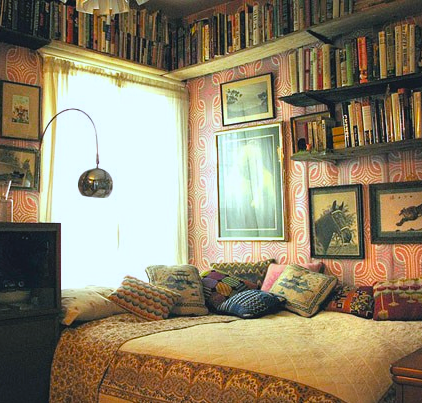
You Are What You Read, Or At Least My House Is
Colson Whitehead wrote a fabulous piece in the NY Times magazine recently, which I only caught by lucky re-tweet coincidence. It’s all about tautophrases, those cliches we love to hate, like hater’s gonna hate (and I hate that my head now autofills “hate hate hate hate”), you be you, it is what it is, etc, etc. I read through it in a blur of giggles and happy memories (Willa Cather! Run DMC! George Bush the younger!) and at the end my impression was that the writing was a true think piece: it put together a series of lusciously readable words in mind-blowing, not necessarily connected sentences that left the reader to decide what they will about what just happened. That’s my favorite kind of piece. I just wanted to swallow all the words, and let them digest.
And as I digested, I thought about another article a co-worker quoted from his week, sternly lumping us listeners, ranging from age 24 through 54, into “that generation” (boomers? x? millenial? w?) that refuses to accept their parents’ things. Things in this case being a wide assortment, from china tea sets to handmade furniture to antique rugs. We/they suck, you see, because, in the opinionated view of this writer/my co-worker, we have no interest in the hand-me-down heirlooms of our ancestors, and instead want to fill our homes with shiny IKEA, CB2, brand spanking new home furnishings. A statement we pointed out, through examples of cherished family heirlooms gracing our homes, was just patently untrue. To me it boiled down to: do you want things in your home that come with a story?
Because when I think about about my dwellings- every single once since I left the nest after high school for college dorm rooms, studio apartments, one bedrooms and finally a home of my very own- the constant has been other people’s things. A writing desk that belonged to an ex’s mom; an etagere from an old cherished friend; china, and the most beautiful cocktail glasses from three sets of grandmas; a lush green divan that calls to mind a 1920s casting couch, gifted from a grad school chum; a perfectly crafted handmade cedar chest, the only object to trek from Idaho to California in the backseat of my mother-in-law’s tiny car as she fled to a ocean-state, small daughter in tow. Each object has its own story, and those stories form part of who I am. They’re my “conscious identity claims,” my “feelings regulators”—things that I cherish because they tell my story. And, in turn, I am who I am because of what I’ve read.
My local library got tired of me when I was young, because I’d come in and browse around thoughtfully like I was checking out new adventures, when in reality no one was fooled: all I wanted to read was the same old fun, sappy, happy, sweet, stuff. Over and over. I’m talking Anne of Green Gables, A Little Princess, Eight Cousins. And that’s where I developed my home decorating style.
I didn’t realize it till years later. One day I found an old battered copy of Alcott’s Eight Cousins, the one where orphaned Rose is sent to live with her family on the Aunt Hill (it’s my favorite Alcott, by far, even over Little Women: I’m still mad about Laurie/Jo), and was shocked to find that the description of Rose’s 19th century east coast bedroom was eerily similar to my first, 20th century, studio: three windows, one facing the “ruddy sunset,” “the soft murmur of the sea” can be heard, there’s a fireplace to warm the evening chill, rugs here & there, “bamboo lounges & chairs,” the bed in a recess, a desk and table sporting “several familiar-looking books,” a Japanese screen divides the space, and topping it off, “a sweet toilet table with an old fashioned mirror,” with “several pretty trays for small matters.” High up in the red-bricked building, overlooking the city roofs, smoke, noise, and lights, that studio was one of the sweetest places I’ve lived. Maybe that’s because I saw it in a romantic light, like little Sara Crew’s attic abode, once she’s banished from the main floors of Miss Minchin’s Select Seminary for Young Ladies. “You can see all sorts of things you can’t see downstairs,” Sara observes. “Chimneys…with smoke curling up in wreaths and clouds going up into the sky…And it all feels as high up—as if it was another world.”
Had I, a young reader, really internalized all of this and not even realized it? My sense of decorating formed from young adult books? I think so. Because it was the same thing with Anne’s House of Dreams in Glen St. Mary, with conch shells decorating the yard and a brook tripping lightly through the corners, and Capt’n Jim’s foghorn sounding tirelessly through the night. I’ve got the shells, leftover from a former tenant’s copious oyster shucking; the foghorn sounds through the dark on the busy Carquinez Straight; no brook yet, and as California is currently drying up I might need to actually move to Nova Scotia to realize that one. But two outta three ain’t bad. “The situation is beautiful. It looks to the sunset and has the great blue harbor before it.” And like Anne’s, my home is filled with old fashioned furniture, books, and love.
(Just think of it: Anne and Gilbert, their childhood meet-cute story, and an episode of Love it or List It! I mean, spoiler alert, they list it, because the House o’ Dreams simply was not built to house six children, a nanny and various pets….)
Some things just get in your head and nest there, until you have reason to call them up for examination. What if I hadn’t read these orphan-meets-world books as a child? Would I still love foghorns, Japanese screens, and attic bedrooms? Am I what I read?
____________________
We run a pretty sweet little bookish Instagram account, if we do say so ourselves (and we do). Come check it out.












